What is a customer data platform (CDP)?
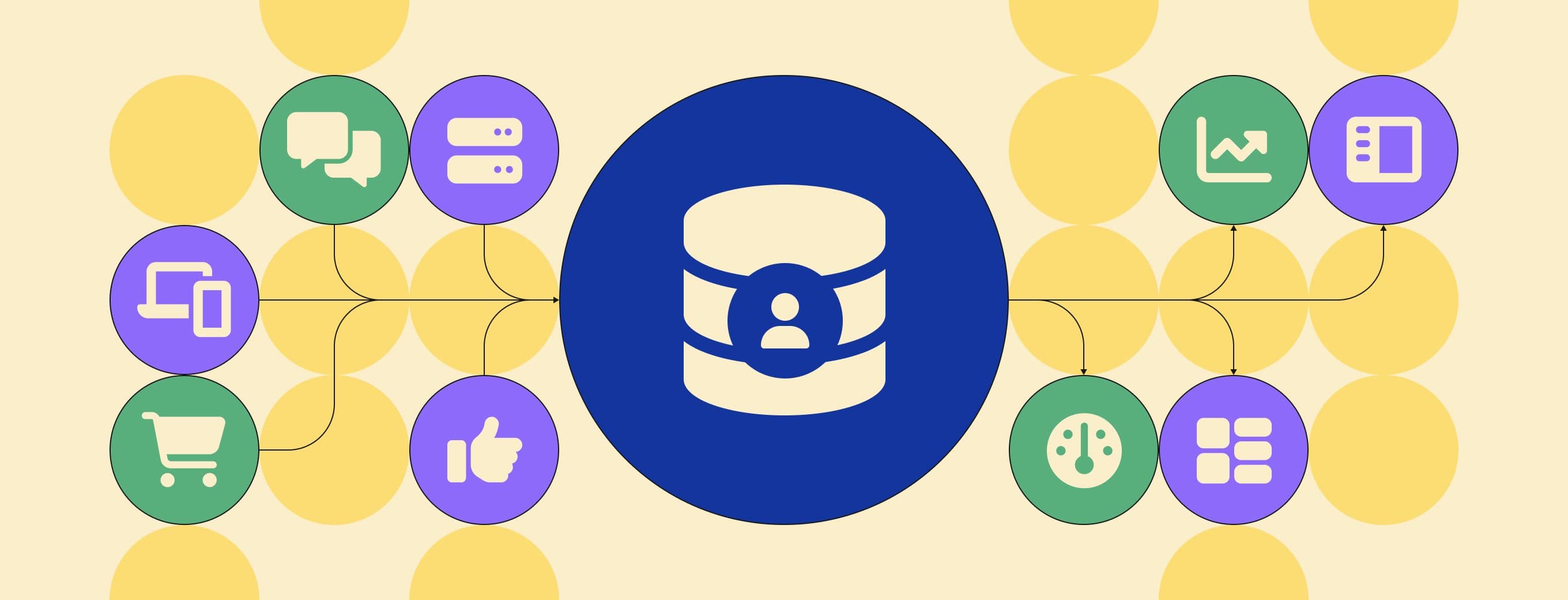
Businesses use customer data platforms (CDP) to collect and unify their customer data into a single customer view. This single customer view, or customer 360, serves as a sole source of truth, keeping every team on the same page with rich, up-to-date customer information.
According to McKinsey, 71% of consumers now expect personalized, end-to-end customer experiences, and the brands that are able to master this gain a tremendous competitive advantage over companies that fail to effectively leverage their customer data.
CDP software is the key to building strong customer relationships at scale. It breaks down data silos and unifies fragmented data systems so that sales and marketing teams can deliver powerful, end-to-end customer experiences.
Since its formal inception in 2010, the CDP has evolved significantly, and today there are many different CDP approaches, including the warehouse native architecture used by RudderStack. In this post, we’ll answer all your questions, from how a CDP works to the benefits of using one and how to choose the right customer data platform software for your business.
Table of contents
- What is a customer data platform (CDP)?
- Why do you need a customer data platform (CDP)?
- CDP vs DMP vs CRM: What's the difference?
- What does a customer data platform (CDP) do?
- The three stages of the data activation lifecycle
- Data collection
- Data unification
- Data activation
- What are the benefits of using a customer data platform (CDP)?
- How other companies use customer data platforms (CDPs)
- Choosing the best customer data platform (CDP)
- Understanding the different types of customer data platforms (CDP)
- Top tips for selecting a customer data platform (CDP)
- Should you build or buy a customer data platform (CDP)?
- Build a world-class customer experience with the RudderStack Warehouse Native Customer Data Platform (CDP)
What is a customer data platform (CDP)?
The customer data platform is still a relatively nascent technology, and it’s rapidly evolving. For this reason, it’s helpful to look at the fundamental goal of the CDP before we offer a definition. CDPs exist to help companies drive more business value with their customer data. There are different approaches to achieving this goal, but CDPs typically perform three key functions: data collection, data unification, and data activation. So, what is a CDP?
A customer data platform (CDP) is a specialized software platform designed to centralize customer data from various sources, unify that data into a customer database of complete customer profiles, and facilitate the activation of those profiles to enrich the quality of customer interactions across every touchpoint. The complete customer profile – often called a single customer view or customer 360 – is the central component of the CDP.
Unlike traditional data management tools, a CDP is designed to eliminate data silos by aggregating and organizing data from multiple first and third-party data sources to create these complete customer profiles. Once the profiles are created, the CDP makes them available – within the CDP itself or downstream systems – to unlock better data analytics, audience segmentation, personalized marketing, machine learning, and more.
Why do you need a customer data platform (CDP)?
The history of the customer data platform is best understood when framed by the challenges businesses face in managing customer data.
Customer data comes from many different sources and is typically scattered across various systems and SaaS platforms. These platforms lock data into their own ecosystems, creating numerous data silos and a fragmented landscape.
With so much opportunity on the table, there has been much innovation aimed at delivering the promise of customer 360. Originally formalized as a SaaS tool for marketing teams, legacy CDPs promised to automatically bring in first-party data from various sources, structure it in a consistent format, and create comprehensive customer profiles that could be used for analytical and marketing purposes.
They also provided orchestration tooling to enable the tactical activation of data for omnichannel customer engagement. For customer-centric marketing teams, this would help ensure a consistent customer experience across web and mobile properties, email, social media, and paid digital advertisements.
However, the issue with using a CDP for marketing is that it will still create another data silo with no easy way for outside teams to access valuable metrics.
Continuing innovation around SaaS tooling and the cloud data warehouse has enabled companies to effectively build CDP software on top of their own data warehouse. These modern CDPs embrace a “build once, use everywhere” mentality and enable every function to take advantage of customer profiles to get deeper customer insights and ensure interactions are personalized, effective, and consistent across channels.
Many innovative companies are now embracing a warehouse native approach to the CDP. In this system, customer data is centralized and unified in the data warehouse. It is then delivered downstream to the tools (including marketing data platforms) that business teams use to drive the customer experience.
Get a demo of RudderStack
Schedule a demo with our team of CDP experts today to learn more about how you can deliver powerful customer experiences on a solid data foundation.
CDP vs DMP vs CRM: What's the difference?
Customer data platforms (CDPs), data management platforms (DMPs), and customer relationship management (CRM) systems are often confused. Here, we’ll clarify distinct capabilities and uses.
- CDP (customer data platform): This software collects and consolidates first-party customer data to form unified customer profiles and make them available for downstream activation. CDPs are often owned and used primarily by marketing teams, but at many companies today, data teams are taking ownership of the CDP and leveraging it to support every team that contributes to the customer experience.
- DMP (data management platform): These mainly collect anonymized web cookie data for use in targeted advertising, typically keeping this data for a short period. They are generally used only by advertising teams.
- CRM (customer relationship management): These systems maintain customer relationships but typically don't include customer interaction data (behavioral data) or transactional details (payments and purchases data). CRMs are primarily owned and used by sales teams.
What does a customer data platform (CDP) do?
If the purpose of a CDP is to help companies drive more value with their customer data by activating complete customer profiles, how does a CDP work? To answer this, let’s explore the three-stage data activation lifecycle:
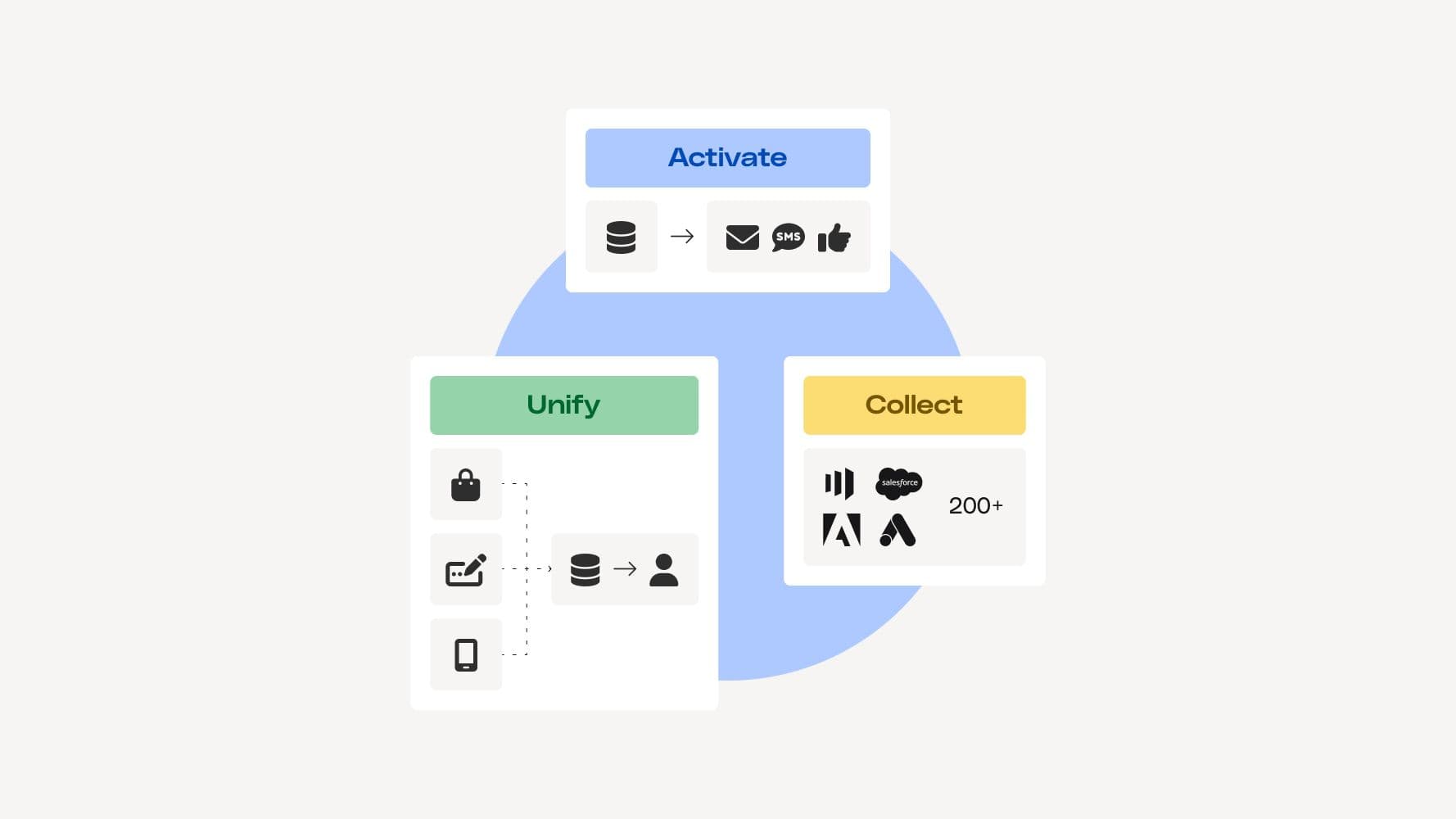
The three stages of the data activation lifecycle
- Data collection: CDPs integrate with various web, mobile, cloud, and server-side data sources to capture valuable first-party customer information from across the entire customer journey.
- Data unification: Customer data platforms perform identity resolution, which involves stitching unique identifiers together from various sources and devices to produce a single canonical record for each customer (or entity).
- Data activation: Once the profiles are built, the CDP makes them available to other systems where marketing, sales, product, and support teams can use them to solve critical use cases, creating a personalized, cohesive end-to-end customer experience.
Data collection
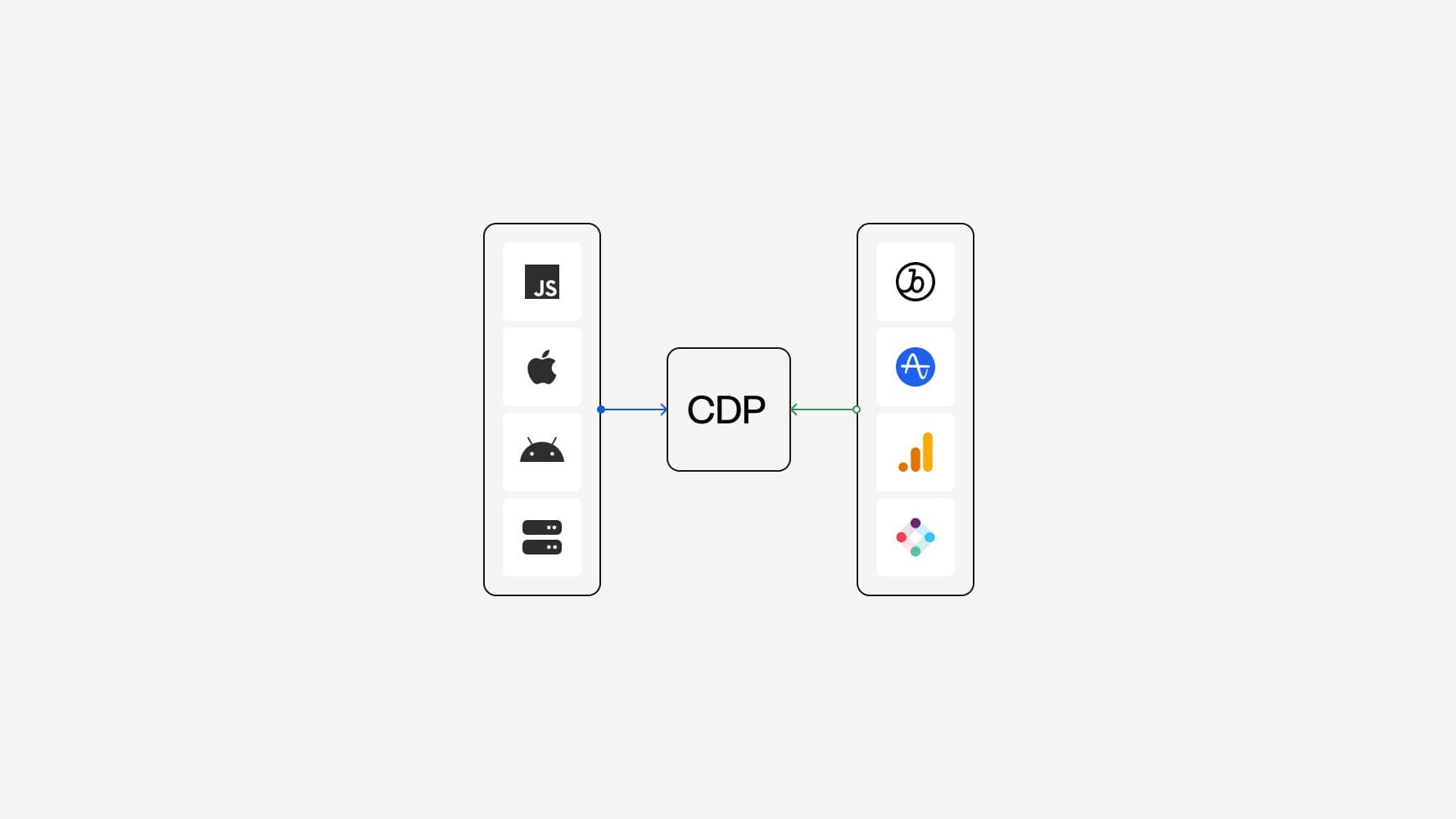
Building a customer 360 begins with collecting data from every customer touchpoint and augmenting it with available enrichment data. The exact makeup of customer profiles will vary across businesses and industries, but it’s helpful to consider the basic building blocks.
First-party data is the most critical data component of the customer profile, but a comprehensive picture of the customer typically includes data from available second and third-party sources. Below, we’ll provide an overview of each data source:
- First-party user behavior data – Called clickstream or event data, this data gets collected in real-time from websites and mobile apps and represents the customer’s digital customer journey. It includes all of the actions taken by users across platforms and devices.
- First-party batch data – Often considered traditional ETL data, batch data includes all customer information, including transactional data such as purchase records and financial transactions, stored in cloud SaaS tools and databases such as a CRM or support desk tool as well as transactional data such as purchase records and financial transactions.
- Second and third-party data – This data can be grouped and called enrichment data. It augments first-party data for more comprehensive customer profiles. Second-party data might come from ad platforms and shipping/delivery systems, while third-party data, purchased from data vendors, can complete the customer picture using browsing, intent, and demographic/firmographic data.
The customer data platform provides data integration capabilities to ingest each of these data types. Once the data is ingested and centralized, it can be combined to create complete customer profiles.
Data unification
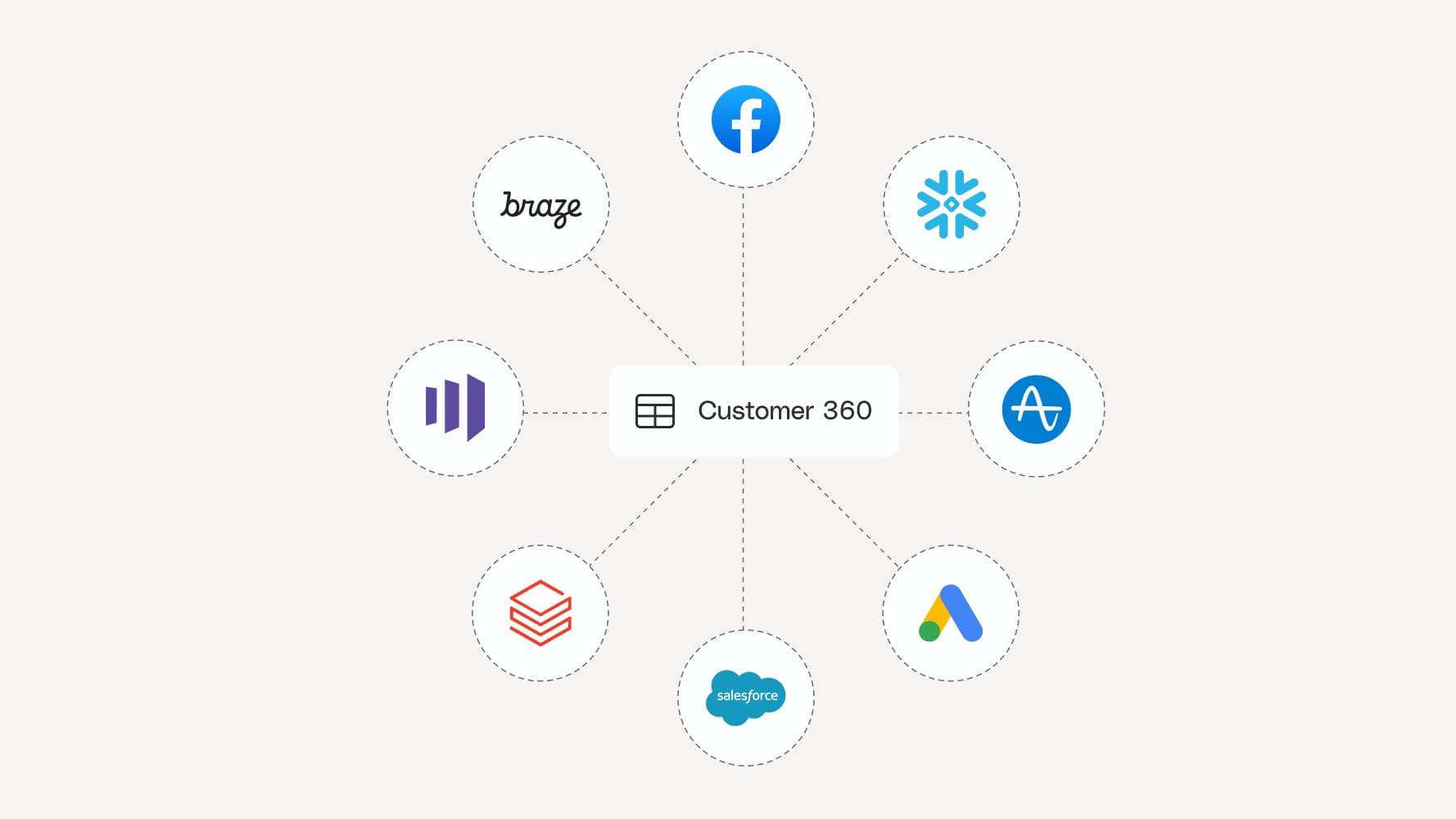
After collecting all relevant customer data, it must be unified to create the customer 360. This involves resolving customer identities to create a unified customer view. With initial unification complete, it’s also possible to build user features to enable specific use cases.
Identity resolution
At the core of data unification is identity resolution, which links all the unique identifiers associated with a customer across different systems. For instance, a customer might use their email for one purchase and a phone number for another or interact with your brand via different channels. These identifiers need to be stitched together into a unified profile to avoid duplicate or fragmented profiles.
The process assigns a canonical identifier to each customer, ensuring all interactions, purchases, and behaviors are connected under one profile. This unified view of the customer enables a deeper understanding of the whole customer journey.
Building user features
Most CDPs provide functionality to build user features from profile data which are often critical for customer segmentation, personalized marketing efforts, and predictive analytics. Many analytics teams call these metrics because they are generally grouped with other KPIs used to run the business. Features are computed from the core customer profile data and added on top. Examples include total purchases and days since last activity.
Data activation
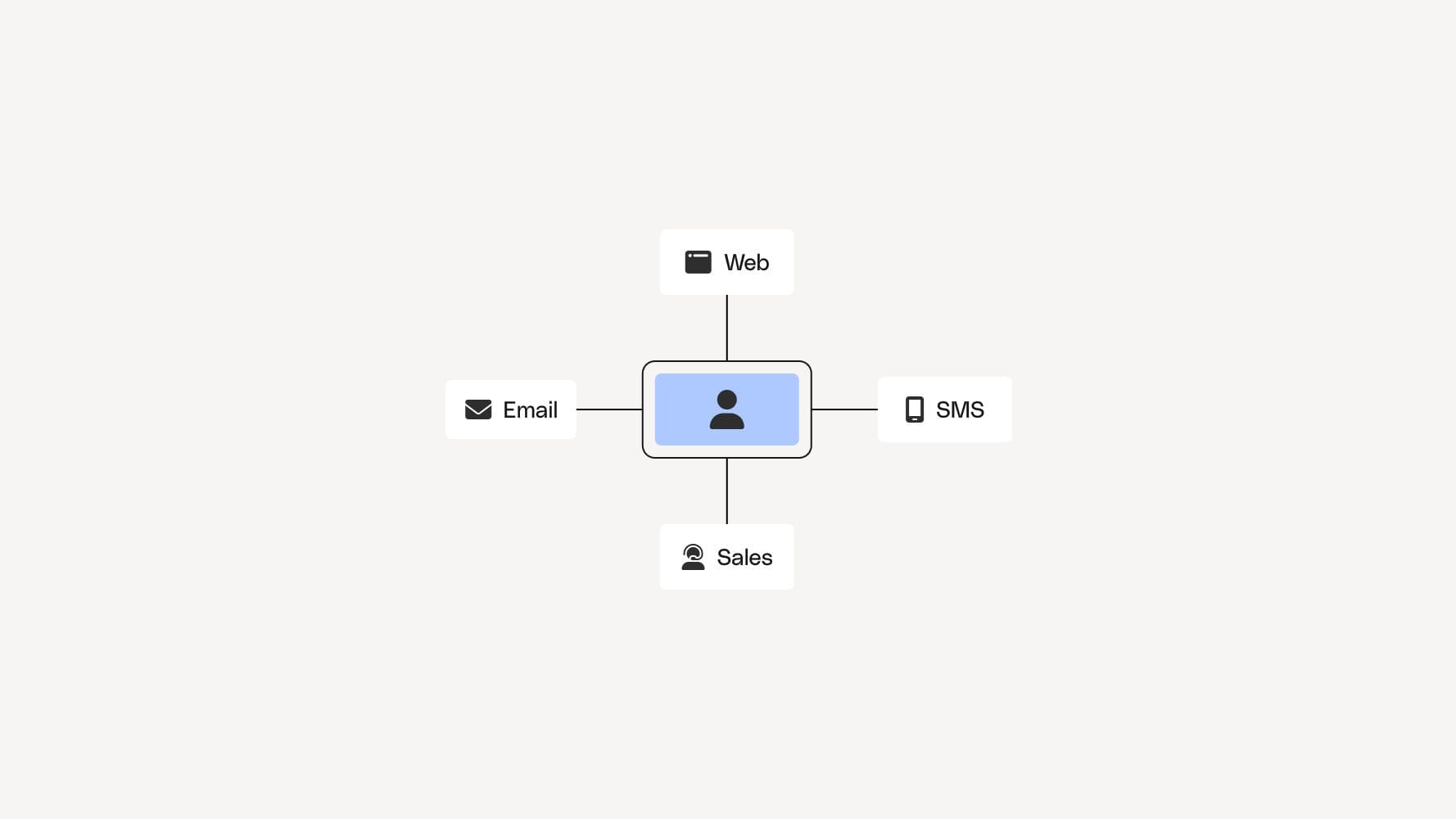
Data activation, broadly, involves the execution of any business activities that are informed and fueled by data. Specifically, the use cases are many: Analytics, personalized marketing, web/app experience personalization, customer segmentation, and AI/ML. Each of these use cases is significantly enhanced when based on customer 360 data from the CDP.
Activating data from a CDP involves making it available to downstream communication platforms for sales, marketing, support, and even web/app experiences. These are often the same tools used to capture these interactions from the “data collection” section above.
Collect, unify, and activate with RudderStack
Schedule a demo with our team of CDP experts today to see RudderStack's data collection, unification, and activation capabilities in action.
What are the benefits of using a customer data platform (CDP)?
With a CDP, you can deliver every bit of relevant customer data to the right people, in the right places, at the right time to craft the connected end-to-end customer experiences that cultivate strong relationships and increase customer lifetime value. CDPs help drive many benefits:
- Simplified data collection and integration – An effective CDP makes it easy to collect data from every source and send it to any destination. It provides a central platform to manage data integration for your entire data and martech stack.
- Optimized customer acquisition and revenue growth – A comprehensive source of truth enables the teams at the forefront of growth to better understand customer behavior, move faster, and make better decisions to increase conversions and drive revenue.
- Personalized customer experience – A customer 360 enables every team with direct customer touchpoints to personalize their engagements based on accurate, up-to-date information. Notably, because the customer 360 eliminates data silos, it helps companies eliminate experiences where the left hand doesn’t know what the right hand is doing.
- Increased operational efficiency – A fragmented customer data landscape leads to redundancy, inefficiencies, and wasted resources. Because a customer 360 eliminates data silos, makes data accessible, and serves it in an activation-ready format, companies can streamline or automate data flows for critical uses.
- Improved customer loyalty and retention – With access to richer customer information, the teams responsible for driving LTV can coordinate efforts to drive loyalty, retention, and expansion.
Real-world results with customer data platforms (CDPs)
With all of the hype around customer 360 and CDPs, it’s fair if it all seems a little overblown. With all of the challenges related to leveraging customer data, it’s also fair if success seems out of reach.
But the truth is that success is attainable, today more than ever, and when you succeed, you can drive a sustained competitive advantage for your company. You don’t have to take our word for it. Here’s how our customers are driving better outcomes with a Warehouse Native CDP:
Wyze delivers AI-driven campaigns with RudderStack profiles and Snowflake
Wyze is now delivering 3x more ML-driven marketing campaigns with RudderStack thanks to a more efficient data function. With data collection and unification solved, data engineering increased productivity 10x. Similarly, the AI team’s productivity has tripled because they’re getting better data to start with, and it’s easier for them to quickly define new features.
RudderStack’s warehouse native approach eliminated the manual processes bogging down our data engineers. With clean data at their disposal and automated workflows to route it downstream, they started providing our AI/ML, marketing, and product teams with actionable information to drive new models and power new processes.
Joybird overcomes data integration challenges
Joybird streamlined data collection and integration with RudderStack, enabling marketing to spin up new, personalized campaigns with valuable data from their Snowflake data warehouse in one hour, a process that used to take two weeks.
RudderStack’s warehouse-first approach gives us the best of both worlds. We have the event data streams that we can activate in real-time. We also send the event data to Snowflake and join it with data from different CRM services to create a richer customer profile that we can then send to downstream destinations such as Iterable via Reverse-ETL.
HealthMatch builds a scalable HIPAA-compliant tech stack
Healthmatch created a new customer engagement workflow and reduced drop-offs from email to login by 12% and unlocked full customer journey analytics with RudderStack. Best of all, because of our Warehouse Native approach, they did it with a fully HIPAA-compliant stack.
HealthMatch is a small company with a big idea. We match over one million patients with 300 plus medical conditions with clinical trial sponsors and researchers in four countries. Despite our vision, we were hampered by our limited technology stack comprising SendGrid and Google Analytics. Over seven days, we built a full-blown customer engagement system using Customer.io and RudderStack.
Choosing the best customer data platform (CDP)
A customer data platform is a significant investment, and choosing the right option can be intimidating. Here, we’ll look at the different types of CDPs and offer some pro tips to help you make a smart decision.
Understanding the different types of customer data platforms(CDPs)
According to the CDP Institute's classification, customer data platforms can be categorized into several distinct types, each with unique features and capabilities. These are the most common types:
- Data CDPs: These platforms focus on accumulating data from various sources, unifying the data into a customer 360, and making these profiles accessible to other business applications.
- Analytics CDPs: These systems provide analytical applications as part of the CDP. They offer customer segmentation and can include AI/ML capabilities and journey mapping.
- Campaign CDPs: These tools provide data collection and analytical capabilities but focus on enabling the creation of dynamic rules that can apply to individual customers within a segment to trigger different actions. They typically support campaign orchestration and marketing automation across channels but do not handle message delivery.
- Delivery CDPs: These systems support collection and analytical capabilities but primarily focus on enabling the creation and delivery of campaigns – such as personalized messaging, outbound marketing, and recommendations – within the platform.
Each type of CDP typically has stronger capabilities in its area of focus and weaker capabilities in other areas. For example, a Data CDP may not have rich campaign creation or delivery capabilities, but its data collection and unification functionalities will be far more advanced and feature-rich than those of a delivery CDP. Alternatively, campaign CDPs typically support only basic data collection and unification capabilities but offer robust functionality and strong user experiences for creating and delivering campaigns.
Many companies leverage a data CDP to build a solid data foundation, which they can use to power the best-of-breed tools their teams use to create and deliver campaigns and experiences.
Top tips for choosing a customer data platform (CDP)
The best customer data platform for you depends on several factors you may value for your business. Data storage, privacy, control, cost, completeness, extensibility, and more. Here are a few considerations that should inform your CDP evaluation:
- How complete is the data coming in? With the new wave of privacy-conscious browser restrictions designed to improve user privacy and weaken the marketplace of data brokers, first-party event collection systems are often affected even though they are not the intended target. Effective CDPs have a number of approaches to tackling external challenges and verifying data quality.
- How good is the data coming in? Do you need tight controls over the quality of data coming in from your application, vendors, and databases? Some CDPs support the concept of Tracking Plans to verify that data coming in has a consistent format that can be used to accurately update a user profile.
- How much control do you have over your data? When working with a customer data platform, do you need to interact with the data directly, or are you ok working with the data through interfaces provided by the CDP? If a CDP shares its data with you or lives on a cloud data warehouse, then you have more visibility into your data and can re-use your customer data profiles for custom processing and analytics, giving you more data control.
- What channels do you use to communicate with customers? B2B organizations have high-value investments in a smaller number of customers through sales processes, while B2C (such as e-commerce or marketplaces) organizations traditionally invest more in digital marketing and advertisements. Different CDP features, such as product optimizations or cost models, may be more advantageous for one or the other.
- How comprehensive is your data privacy program? Data privacy laws such as GDPR and CCPA put stricter controls on customer data collection, access, storage, and activation. A CDP should be able to provide compliance for both data within its system and forward deletion requests to downstream systems. In addition, some CDPs may go one step further with compliance for medical data (HIPAA). Read more on the role your CDP can play in data privacy.
Should you build or buy a customer data platform (CDP)?
Off-the-shelf CDPs provide some powerful capabilities and can deliver time to value for data activation use cases, but they do come with some notable drawbacks:
- Data lock-in and vendor lock-in: Off-the-shelf CDPs keep your data inside of their walled gardens and often require multi-year contracts
- Lack of flexibility: Your ability to modify and customize bought tools is often significantly limited by UI-based workflows
- Lack of support for complex use cases: Bought solutions often don’t support advanced needs like complex identity resolution, real-time personalization, and AI/ML.
- High cost: CDPs processing and storing data can quickly become expensive, especially as data volume grows.
- Compliance risk: Off-the-shelf CDPs that store a copy of your data make it challenging to meet complex regulatory requirements.
Because of these limitations, companies with the necessary resources can be tempted to build customer data platform capabilities in-house. The DIY approach can seem attractive at the surface level because it delivers more control and flexibility and avoids lock-in.
In reality, these customer data management projects are resource-intensive and create a significant maintenance burden. Teams that undertake them often end up spending so much time mired in the complexity of building pipelines and endless data modeling that they can’t focus on making the data useful.
RudderStack CEO Soumyadeb Mitra knows firsthand the challenges of these projects, which he details in this post Build or Buy? Lessons From Ten Years Building Customer Data Pipelines. At a high level, here are the issues you’ll face if you decide to go the DIY route:
- Scaling the infrastructure to support millions of events per day and more
- Building and maintaining Integrations for all the necessary data sources and destinations, such as databases, other SaaS products, and advertising platforms like Google Ads
- Transforming the data into a standardized format and ensuring the data is being updated correctly with new events
- Accounting for privacy regulations like GDPR and CCPA
- Supporting internal demand for integrations while maintaining existing ones (e.g., changes in destination API versions, deprecated endpoints, etc.)
- Solving identity resolution and scaling the customer 360
Recognizing the drawbacks of the available bought and built solutions, and taking advantage of the modern cloud data warehouse, RudderStack provides an alternative that delivers the best of both worlds: the Warehouse Native CDP.
See The Warehouse Native CDP in action
If you would like to find out more about how RudderStack can help turn your customer data into a competitive advantage, request a demo today.
Published:
November 26, 2024
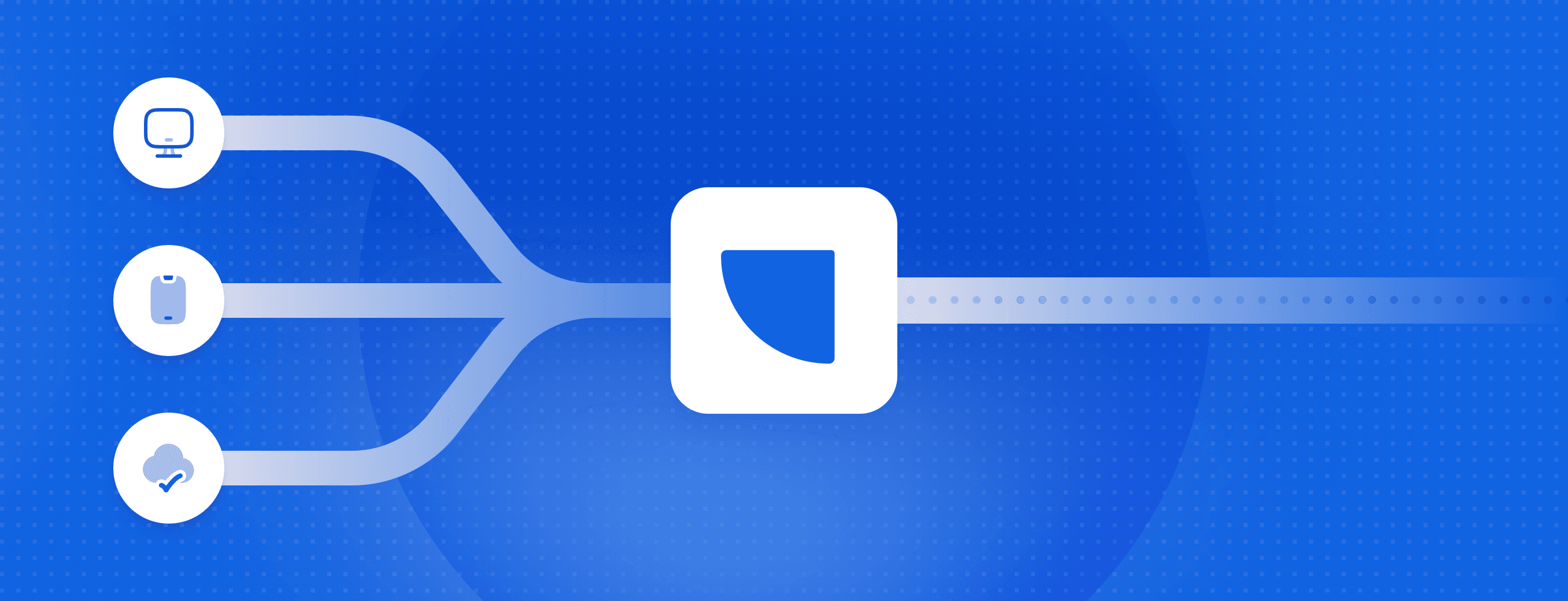
Event streaming: What it is, how it works, and why you should use it
Event streaming allows businesses to efficiently collect and process large amounts of data in real time. It is a technique that captures and processes data as it is generated, enabling businesses to analyze data in real time

How Masterworks built a donor intelligence engine with RudderStack
Understanding donor behavior is critical to effective nonprofit fundraising. As digital channels transform how people give, organizations face the challenge of connecting online versus offline giving.

How long does it take you to see a customer event? If it's over five seconds, you're missing out
Access to real-time customer data is no longer a luxury. This article explains how a modern, modern, real-time infrastructure can help you close the gap between customer intent and action—before it’s too late.





